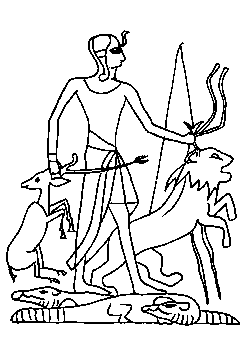
This god, called 'Saviour', is known from the 18th Dynasty on. We know from personal names that the saving characteristic of divine powers was already known and worshipped in the Early Period, and this remained the case throughout Egypt's history. Most of the great gods have the epithet 'Saviour'.
During the New Kingdom a sense of loneliness and isolation began to increase in society, which resulted in texts being written that emphasized the saving aspect of diving powers, particularly in the Ramesside period. This aspect was personified in the god Shed, although the transition from epithet to independent god is not always clear.
Shed is depicted as a child or young man, often nude, but also wearing a loincloth that must be interpreted as the clothing of a young prince (Horus). He always has the sidelock of youth. His attributes are a bow and arrow, and sometimes a lance as well. He holds wild animals in his hands and is usually standing on two crocodiles. He also appears being pulled through the sky in a chariot drawn by horses or griffons. His role is to provide protection against dangerous animals, but he can also function as a healer if the evil has already occurred.
Shed is closely linked with Horus, whose youthful stature he has adopted. He also appears together with other healing gods, such as Isis or Onuris. Gradually he became amalgamated into Horus-Shed, and was eventually superseded by this redeeming child. After the 6th century BC, Horus stelae replace Shed stelae and take over many of their characteristics.
Two stelae dedicated to him were found at Amarna in one of the tomb chapels from the late Amarna period. Many stelae dedicated to Shed have been found at Deir el-Medina. As a 'god of the people' he did not have his own temple or chapel but he is often depicted on plaques which were worn as amulets.